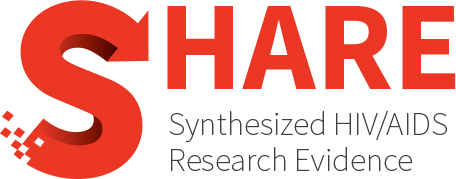Category Archives: Determinants of Health
Vaginal practices as women’s agency in Sub-Saharan Africa: A synthesis of meaning and motivation through meta-ethnography
This paper reports on a systematic review of qualitative research about vaginal practices in Sub-Saharan Africa, which used meta-ethnographic methods to understand their origins, their meanings for the women who...
Social network-based interventions to promote condom use: A systematic review
Effective sexually transmitted infection (STIs)/HIV prevention programs are urgently needed, but translating evidence-based methods of STI/HIV prevention into sustainable programs has been difficult. Social influences are critical for establishing condom...
Effects of postnatal interventions for the reduction of vertical HIV transmission on infant growth and non-HIV infections: A systematic review
INTRODUCTION: Guidelines in resource-poor settings have progressively included interventions to reduce postnatal HIV transmission through breast milk. In addition to HIV-free survival, infant growth and non-HIV infections should be considered....
Influence of mhealth interventions on gender relations in developing countries: A systematic literature review
INTRODUCTION: Research has shown that mHealth initiatives, or health programs enhanced by mobile phone technologies, can foster women’s empowerment. Yet, there is growing concern that mobile-based programs geared towards women...
Literature review of HIV among female sex workers in the Central Asian Republics, Afghanistan, and Mongolia: Contexts and convergence with drug use
BACKGROUND: Central Asia is culturally and demographically diverse, both between and within its respective countries. That diversity is represented in the range of individual, network, community, and structural risks for...
Human immunodeficiency disease: How should it affect surgical decision making?
BACKGROUND: The ever-increasing prevalence of human immunodeficiency virus (HIV) infection and the continued improvement in clinical management has increased the likelihood of surgery being performed on patients with this infection....
No relationship between TNF-alpha genetic variants and combination antiretroviral therapy-related lipodystrophy syndrome in HIV type 1-infected patients: A case-control study and a meta-analysis
Tumor necrosis factor alpha (TNF-alpha) is thought to be involved in the pathogenic and metabolic events associated with HIV-1 infection. We assessed whether carriage of the TNF-alpha gene promoter single...
The effectiveness and cost implications of task-shifting in the delivery of antiretroviral therapy to HIV-infected patients: A systematic review
INTRODUCTION: Human resource shortages are a challenge to the rollout of antiretroviral therapy (ART) for HIV-infected patients, particularly in sub-Saharan Africa. Task-shifting has been recommended as an approach to reduce...
Lower HIV prevalence among Asian/Pacific Islander men who have sex with men: A critical review for possible reasons
We conducted a critical literature review for possible reasons that may explain the lower HIV prevalence observed among API MSM compared to MSM of other races/ethnicities. Trends emerging from the...
Role and outcomes of community health workers in HIV care in sub-Saharan Africa: A systematic review
Introduction: The provision of HIV treatment and care in sub-Saharan Africa faces multiple challenges, including weak health systems and attrition of trained health workers. One potential response to overcome these...
